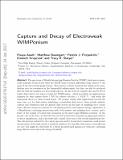| dc.contributor.author | Asadi, Pouya | |
| dc.contributor.author | Baumgart, Matthew Todd | |
| dc.contributor.author | Fitzpatrick, Patrick John | |
| dc.contributor.author | Krupczak, Emmett E. | |
| dc.contributor.author | Slatyer, Tracy Robyn | |
| dc.date.accessioned | 2019-03-11T16:31:01Z | |
| dc.date.available | 2019-03-11T16:31:01Z | |
| dc.date.issued | 2017-02 | |
| dc.identifier.issn | 1475-7516 | |
| dc.identifier.uri | http://hdl.handle.net/1721.1/120861 | |
| dc.description.abstract | The spectrum of Weakly-Interacting-Massive-Particle (WIMP) dark matter generically possesses bound states when the WIMP mass becomes sufficiently large relative to the mass of the electroweak gauge bosons. The presence of these bound states enhances the annihilation rate via resonances in the Sommerfeld enhancement, but they can also be produced directly with the emission of a low-energy photon. In this work we compute the rate for SU(2) triplet dark matter (the wino) to bind into WIMPonium - which is possible via single-photon emission for wino masses above 5 TeV for relative velocity v < O(10-2) - and study the subsequent decays of these bound states. We present results with applications beyond the wino case, e.g. for dark matter inhabiting a nonabelian dark sector; these include analytic capture and transition rates for general dark sectors in the limit of vanishing force carrier mass, efficient numerical routines for calculating positive and negative-energy eigenstates of a Hamiltonian containing interactions with both massive and massless force carriers, and a study of the scaling of bound state formation in the short-range Hulth'{e}n potential. In the specific case of the wino, we find that the rate for bound state formation is suppressed relative to direct annihilation, and so provides only a small correction to the overall annihilation rate. The soft photons radiated by the capture process and by bound state transitions could permit measurement of the dark matter's quantum numbers; for wino-like dark matter, such photons are rare, but might be observable by a future ground-based gamma-ray telescope combining large effective area and a low energy threshold. | en_US |
| dc.publisher | IOP Publishing | en_US |
| dc.relation.isversionof | http://dx.doi.org/10.1088/1475-7516/2017/02/005 | en_US |
| dc.rights | Creative Commons Attribution-Noncommercial-Share Alike | en_US |
| dc.rights.uri | http://creativecommons.org/licenses/by-nc-sa/4.0/ | en_US |
| dc.source | arXiv | en_US |
| dc.title | Capture and decay of electroweak WIMPonium | en_US |
| dc.type | Article | en_US |
| dc.identifier.citation | Asadi, Pouya, Matthew Baumgart, Patrick J. Fitzpatrick, Emmett Krupczak, and Tracy R. Slatyer. “Capture and Decay of Electroweak WIMPonium.” Journal of Cosmology and Astroparticle Physics 2017, no. 02 (February 1, 2017): 005–005. | en_US |
| dc.contributor.department | Massachusetts Institute of Technology. Department of Aeronautics and Astronautics | en_US |
| dc.contributor.department | Massachusetts Institute of Technology. Department of Physics | en_US |
| dc.contributor.mitauthor | Baumgart, Matthew Todd | |
| dc.contributor.mitauthor | Fitzpatrick, Patrick John | |
| dc.contributor.mitauthor | Krupczak, Emmett E. | |
| dc.contributor.mitauthor | Slatyer, Tracy Robyn | |
| dc.relation.journal | Journal of Cosmology and Astroparticle Physics | en_US |
| dc.eprint.version | Author's final manuscript | en_US |
| dc.type.uri | http://purl.org/eprint/type/JournalArticle | en_US |
| eprint.status | http://purl.org/eprint/status/PeerReviewed | en_US |
| dc.date.updated | 2019-02-06T15:36:57Z | |
| dspace.orderedauthors | Asadi, Pouya; Baumgart, Matthew; Fitzpatrick, Patrick J.; Krupczak, Emmett; Slatyer, Tracy R. | en_US |
| dspace.embargo.terms | N | en_US |
| dc.identifier.orcid | https://orcid.org/0000-0002-2729-3267 | |
| dc.identifier.orcid | https://orcid.org/0000-0001-9699-9047 | |
| mit.license | OPEN_ACCESS_POLICY | en_US |
